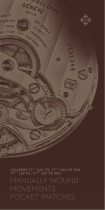Patek Philippe 7059 Mode d'emploi
- Catégorie
- Montres
- Taper
- Mode d'emploi

English
Français
Deutsch

English

Patek Philippe lives up to its commitment
to women by casing its precious caliber
CHR 27‑525 PS Grand Complication movement,
the world’s thinnest split‑seconds chronograph
with column wheel control, in rose gold to create
a model of seductive elegance. The “Ladies First
Split Seconds Chronograph” features a diamond‑
set bezel that frames a cream‑colored grained
opaline dial. It is an exceptional timepiece for
the exceptional woman.
Reference 7059
Caliber CHR 27-525 PS
Ultra-thin manually wound wristwatch
with split-seconds monopusher chronograph.

Haute horlogerie at its very finest
Patek Philippe’s caliber CHR 27‑525 PS is the world’s
thinnest split‑seconds monopusher chronograph
movement with column wheel control: it is a scant
5.25 mm thick. Not least, this record was achieved
thanks to an unusual design approach for the conti‑
nuously running 60‑minute counter. This innova‑
tion not only results in a slimmer silhouette, it also
offsets the torque differences between the running
and stopped states of the chronograph.
The three chronograph wheels (driving, clutch, and
seconds wheels) are another exclusive feature of
the CHR 27‑525 PS movement. Their innovative and
patented toothing geometries reduce wear and op‑
timize power transmission within the chronograph
mechanism.
The pinnacle of artisanship
The caliber CHR 27‑525 PS movement is a classic
split‑seconds chronograph construction with
two column wheels that, as always at Patek Phi‑
lippe, are crowned by polished caps. The bridges
à l’ancienne are meticulously chamfered, polished,
and decorated with Geneva striping. Each caliber
is hand‑crafted one by one by a master watchmaker
in the manufacture’s Haute Horlogerie ateliers.
Practically every component is individually fi‑
led, chamfered, polished, adjusted, and finished.
Subsequently, the watchmaker performs a trial
assembly, the so‑called repassage en blanc, to ve‑
rify the functional integrity of the movement.
Afterwards, the caliber is completely disassem‑
bled again. When all parts have been cleaned,
they are reassembled, lubricated, and fine‑tuned.
This ancestral method produces horological mas‑
terpieces that exceed the expectations of even
the most discerning aficionados.
A paragon of style
To complement the bright luster of the polished
steel case, Patek Philippe designed an iridescent
silvery dial with a railway track minute scale that
underscores the masculine, technical look of the
split‑seconds chronograph. The delicate black‑
lacquered engravings in the corners of the dial are
unique signature elements. The cushion‑shaped
sapphire‑crystal glass is gently cambered, as is the
display back that affords a stunning view of the
movement and the satin‑finished surround with its
gold‑filled engravings. The sapphire‑crystal back
can be replaced with an interchangeable solid steel
back that comes with the watch.

Split-seconds button
Winding crown
Position 1: to wind the watch
Position 2: to set the time
Subsidiary seconds
Split-seconds hand Chronograph button
60-minute counter
1 2
Chronograph hand
Instructions
WINDING CROWN
The winding crown is used to wind the watch
(position 1) and to set the time (position 2)
MANUALLY WOUND
Your watch has a manually wound movement.
When fully wound, it has a power reserve of at
least 48 hours. We recommend that you wind
your watch each day at about the same time,
preferably in the morning (about 25 clockwise
turns of the crown).
Caution: Please wind the watch before you put it on. This
way, you can avoid lateral pressure on the winding stem
which in the course of the years could damage the stem
tube. Turn the crown gently and uniformly and stop as soon
as you feel resistance; if you wind the watch too vigorously,
this might damage the movement.
SETTING THE TIME
To set the time, pull the crown out, and turn it
in either direction. Once the correct time is set,
press the crown home again. The movement has a
stop-seconds mechanism (balance wheel blocker)
that allows the watch to be synchronized with
a time signal to an accuracy of one second. The
seconds hand stops when the winding crown is
pulled. It starts running again as soon as you push
the crown home again.
Caution: Please set the time only when the chronograph
is stopped, and preferably – to prevent lateral pressure on
the winding stem – before you put the watch on. We recom-
mend that you turn the crown only with two fingers and use
your fingernails to pull it out.

CHRONOGRAPH
The Patek Philippe rattrapante chronograph
allows you to measure the duration of events,
record lap times. These measurements are perfor-
med with the two large sweep stop hands – the
chronograph and rattrapante hands – and with
the small 60-minute counter at 3 o’clock. Unlike
most split seconds chronographs, the Ref. 7059
is a three-phase chronograph that requires only
two pushers.
Actuating the pusher in the winding crown se-
quentially activates the three following com-
mands:
1. Simultaneously start the chronograph and
rattrapante hands,
2. Simultaneously stop the chronograph and
rattrapante hands,
3. Reset the chronograph and rattrapante hands.
The pusher at 2 o’clock controls only the rattrapante hand.
MEASURING DURATIONS AND STOPPING LAP TIMES
When the event to be timed begins, actuate the
pusher in the winding crown: The superposed
chronograph and rattrapante hands begin to run.
To measure a lap time, press the pusher at 2 o’clock:
The rattrapante hand will stop but the chronograph
hand keeps running. Now you can take a note of
the lap time. When you actuate the pusher at 2
o’clock again, the rattrapante hand will catch up
with the chronograph hand and both hands, now
superposed, will continue running. This function
can be activated as many times as you wish. To stop
the final time, actuate the pusher in the winding
crown: this will stop the chronograph hand and
you can take a note of the duration of the event.
When you actuate the pusher in the winding crown
again, the chronograph and rattrapante hands will
both return to zero.
Caution: To reset the chronograph and rattrapante hands
to zero at the same time, they must be superposed. If the rat-
trapante hand is still indicating a lap time, actuate the pusher
at 2 o’clock to make it catch up with the chronograph hand,
and then reset both hands to zero by actuating the pusher in
the winding crown.

Movement technical data
CALIBER: CHR 27-525 PS, MANUALLY WOUND
DIAMETER: 27.30 MM
HEIGHT: 5.25 MM
NUMBER OF PARTS: 252
NUMBER OF JEWELS: 27
POWER RESERVE: WITH THE CHRONOGRAPH DISENGAGED:
48 HOURS MIN.
BALANCE: GYROMAX ®
FREQUENCY: 21,600 SEMI-OSCILLATIONS PER HOUR (3 Hz)
BALANCE SPRING: BREGUET
HALLMARK: PATEK PHILIPPE SEAL

Recommendations
WATER RESISTANCE
The case of your wristwatch is fitted with different
types of seals that protect the movement against
dust, humidity, ingress of moisture. However, if
your watch receives a blow the crown or the crys‑
tal, its water resistance may be impaired.
If your watch has a leather strap, we recommend that avoid
exposing it to water altogether.
SERVICE
We recommend that you have your watch ser‑
viced at least once every three to five years. For
this purpose, we suggest you take it to an Autho‑
rized Patek Philippe Retailer who will send it to
our Geneva manufacture. You can then be assured
that your watch will be cared for by a qualified
master watchmaker at the Patek Philippe head‑
quarters in Geneva.
The master watchmaker will disassemble the mo‑
vement and then inspect, clean, and lubricate
all the individual parts prior to reassembly. The
watch will also be tested and the escapement
regulated if necessary. Finally, its performance
and rate accuracy will be monitored for a period
of two weeks.
The entire process may take several weeks
because each watch must undergo a complete
series of tests to fulfill the strict quality criteria
of Patek Philippe.
If you have any questions regarding service issues, please
contact your nearest Authorized Patek Philippe Retailer or
our International Customer Service Department in Geneva.
You may also visit www.patek.com.
WINDING
When fully wound, your wristwatch has a power
reserve of at least 40 hours. We recommend that
you wind your watch at about the same time
every day.
We advise you to wind the watch before you put it on.
This way, you can avoid lateral pressure on the winding
stem which, in the course of the years, could damage the
stem tube. The same applies to handsetting. Please use your
fingernails to pull the crown out and turn it gently between
two fingertips.
PATEK PHILIPPE SEAL
The Patek Philippe Seal is a global emblem of qua‑
lity that applies to the completed and fully cased
watch. It covers the movement, the case, the dial,
the hands, the pushers, the straps and bracelets,
the clasps, as well as all other components that
contribute to the accuracy and aesthetic appeal
of a watch. It takes technical, functional, and
design‑related aspects into account and also
covers the visual appearance of the watch, its
rate accuracy and dependability, as well as the
quality of the customer service to which its owner
is entitled. It encompasses the entire know‑how
and the unique facets that govern the develop‑
ment, production, and long‑term maintenance of
an exceptional timepiece.

Français

Patek Philippe décline l’exploit au féminin en
proposant pour la première fois le précieux
calibre à grande complication CHR 27-525 PS
– le chronographe à rattrapante et roues à
colonnes le plus plat du monde – dans un
nouveau modèle en or rose à l’esthétique très
raffinée, le Ladies First Split Seconds Chronograph.
La lunette sertie de diamants encadre un
élégant cadran grené opalin. Un modèle
d’exception pour femme d’exception.
Référence 7059
Calibre CHR 27-525 PS
Montre-bracelet extra-plate
avec chronographe monopoussoir à rattrapante
et remontage manuel.

Un chef-d’œuvre de haute horlogerie
Avec le calibre CHR 27-525 PS, Patek Philippe a
créé le mouvement chronographe monopoussoir
à rattrapante et roues à colonnes le plus plat
jamais réalisé: 5,25 mm d’épaisseur. Cette
prouesse s’explique notamment par la
construction particulière du compteur 60
minutes «traînant» (tournant en continu),
une innovation qui permet de faire d’une
pierre deux coups en réduisant la hau-
teur du mouvement, tout en disposant d’un
système de compensation des différences de
couples entre chronographe enclenché et arrêté.
Autre exclusivité introduite sur le calibre CHR
27-525 PS: les trois roues du mécanisme de chro-
nographe (roue entraîneuse de chronographe,
roue d’embrayage et roue intermédiaire) pré-
sentent des profils de dents brevetés permettant
de réduire l’usure tout en optimisant le fonc-
tionnement du chronographe.
Un fleuron d’artisanat
Le calibre CHR 27-525 PS présente une construc-
tion de chronographe classique avec deux roues
à colonnes dotées, comme toujours chez Patek
Philippe, de chapeaux polis. Les ponts à l’ancienne
sont soigneusement anglés, polis et ornés d’un
décor de Côtes de Genève. Chaque calibre est
fabriqué à l’unité entre les mains d’un maître
horloger au sein des ateliers de «Haute Hor-
logerie». Tous les composants sont un à un li-
més, anglés, polis, ajustés et terminés. Les horlo-
gers effectuent ensuite un assemblage test appelé
«repassage en blanc» afin de contrôler toutes
les fonctions, puis l’ensemble est à nou-
veau entièrement démonté, nettoyé, réas-
semblé, lubrifié et réglé. Ces méthodes de
fabrication à l’ancienne donnent naissance à des
chefs-d’œuvre dépassant toutes les attentes des
connaisseurs les plus exigeants.
Un design de grand style
Pour faire écho à l’éclat du boîtier coussin en
acier poli, Patek Philippe a conçu un cadran opa-
lin argenté doté d’une minuterie «chemin de fer»
soulignant le style masculin et technique de ce
chronographe à rattrapante. Détail original et
raffiné: les quatre coins du cadran s’ornent d’un
décor gravé noir évoquant des feuillages stylisés.
Le verre saphir présente une forme coussin déli-
catement bombée, reprise par le fond transparent
offrant une vue plongeante sur le mouvement.
Le calibre est encadré par une plaque de recou-
vrement satinée soleil avec décor gravé doré. Le
fond saphir peut être remplacé par un fond plein
en acier livré avec la montre.

Poussoir de rattrapante
Couronne de remontoir
Position 1: remontage
Position 2: mise à l’heure
Petite seconde
Aiguille de rattrapante Poussoir de chronographe
Compteur 60 minutes
1 2
Aiguille de chronographe
Mode d’emploi
COURONNE DE REMONTOIR
Le remontage (position 1) et la mise à l’heure
(position 2) s’effectuent à l’aide de la couronne
de remontoir.
REMONTAGE
Votre montre est dotée d’un mouvement à re-
montage manuel. Complètement remontée, elle
bénéficie d’une réserve de marche de minimum
48 heures. Nous vous recommandons de la
remonter tous les jours plus ou moins à la
même heure, de préférence le matin (environ
25 tours de couronne, dans le sens des aiguilles
d’une montre).
Attention: il est préférable d’effectuer ce remontage
hors du poignet pour éviter les pressions latérales qui, au fil
des ans, risqueraient d’endommager le tube de la couronne
de remontoir. Tournez la couronne doucement et réguliè-
rement, en arrêtant dès que vous sentez une résistance; un
remontage trop énergique peut endommager le mouvement
MISE À L’HEURE
L’heure se règle en tirant doucement la couronne
et en déplaçant les aiguilles vers l’avant ou vers
l’arrière. Lorsque les aiguilles indiquent la bonne
heure, poussez la couronne dans sa position ini-
tiale (contre le boîtier). Le mouvement comporte
un système de «stop seconde» (arrêt du balancier)
qui vous permet de faire une mise à l’heure à la
seconde près. Lorsque vous tirez sur la tige de
remontoir, l’aiguille des secondes s’arrête instan-
tanément. Elle redémarre immédiatement lorsque
vous repoussez la couronne contre le boîtier après
avoir fait la mise à l’heure.
Attention: la mise à l’heure doit être effectuée exclusive-
ment avec le chronographe arrêté, et de préférence hors du
poignet, afin d’éviter les pressions latérales sur le tube de la
couronne. Nous vous recommandons de n’utiliser que deux
doigts et de faire levier avec l’ongle pour tirer la couronne.

CHRONOGRAPHE
Le chronographe à rattrapante Patek Philippe
vous permet de chronométrer des événements,
de mesurer des temps intermédiaires. Il possède
pour cela deux grandes aiguilles des secondes au
centre du cadran – l’aiguille de chronographe et
l’aiguille de rattrapante – ainsi qu’une aiguille des
minutes sur un petit compteur 60 minutes à 3h.
Contrairement à la plupart des chronographes à
rattrapante, la référence 7059 Patek Philippe est
ce qu’on appelle un «chronographe trois temps»,
qui ne nécessite que deux poussoirs.
En appuyant sur le poussoir logé dans la couronne,
on active successivement les trois fonctions sui-
vantes:
1. démarrage simultané des aiguilles de chrono-
graphe et de rattrapante,
2. arrêt simultané des aiguilles de chronographe
et de rattrapante,
3. remise à zéro des aiguilles de chronographe
et de rattrapante.
Le poussoir à 2h sert exclusivement aux commandes de
l’aiguille de rattrapante.
MESURE D’UN TEMPS INTERMÉDIAIRE
Pour lancer le chronométrage, pressez sur le
poussoir logé dans la couronne: l’aiguille de chro-
nographe et l’aiguille de rattrapante, superposées,
se mettent en marche. Pour mesurer un temps
intermédiaire, pressez sur le poussoir à 2h: l’ai-
guille de rattrapante s’immobilise, tandis que l’ai-
guille de chronographe poursuit sa course. Vous
pouvez maintenant lire le temps intermédiaire.
Si vous pressez à nouveau sur le poussoir à 2h,
l’aiguille de rattrapante rejoint instantanément
l’aiguille de chronographe et les deux aiguilles
poursuivent leur course en parfaite synchronisa-
tion. Vous pouvez répéter ce processus aussi sou-
vent que vous le désirez. Pour mesurer le temps
final, actionnez le poussoir logé dans la couronne:
l’aiguille de chronographe s’arrête et vous pouvez
lire le temps mesuré. Une nouvelle pression sur
le poussoir logé dans la couronne vous permettra
de remettre à zéro les deux aiguilles de chrono-
graphe et de rattrapante.
Attention: pour pouvoir être remises à zéro ensemble,
les aiguilles de chronographe et de rattrapante doivent être
superposées. Si l’aiguille de rattrapante est encore arrêtée
sur un temps intermédiaire, commencez par lui faire «rat-
traper» l’aiguille de chronographe grâce au poussoir à 2h,
avant de remettre à zéro les deux aiguilles à l’aide du poussoir
logé dans la couronne.

Caractéristiques
CALIBRE: CHR 27-525 PS, REMONTAGE MANUEL
DIAMÈTRE: 27,30 MM
ÉPAISSEUR: 5,25 MM
NOMBRE DE COMPOSANTS: 252
NOMBRE DE RUBIS: 27
RÉSERVE DE MARCHE: AVEC LE CHRONOGRAPHE NON ENCLENCHÉ :
48 HEURES MIN.
BALANCIER: GYROMAX ®
FRÉQUENCE: 21 600 ALTERNANCES PAR HEURE (3 Hz)
SPIRAL: BREGUET
SIGNE DISTINCTIF: POINÇON PATEK PHILIPPE

Recommandations
ETANCHÉITÉ
Votre montre est dotée de joints et de fermetures
construits pour préserver le mouvement de la
poussière, de l’humidité et même de tout risque
de détérioration en cas d’immersion. Un choc sur
la couronne ou sur la glace de votre montre risque
toutefois d’en affecter l’étanchéité. Par ailleurs, si
votre montre est munie d’un bracelet en cuir, nous vous
suggérons d’éviter qu’elle n’entre en contact avec l’eau.
ENTRETIEN
Nous vous recommandons de faire réviser votre
montre au moins une fois tous les trois à cinq ans.
Nous vous suggérons pour cela de la remettre à un
agent agréé Patek Philippe qui se chargera de l’en-
voyer à la manufacture. Vous serez ainsi assuré
que votre montre sera contrôlée par un maître
horloger qualifié chez Patek Philippe, à Genève.
Le maître horloger démontera complètement le
mouvement, nettoiera tous ses composants, le
vérifiera puis réassemblera le mécanisme en
lubrifiant les pièces qui l’exigent. Après avoir testé
le bon fonctionnement de la montre et procédé,
si nécessaire, au réglage de l’échappement, il
gardera la montre au moins deux semaines sup-
plémentaires afin d’en régler la marche.
L’ensemble du service peut prendre plusieurs
semaines, car il dépend de la procédure de tests
complète établie pour répondre aux normes de
qualité Patek Philippe.
Pour toute question concernant l’entretien de votre montre,
vous pouvez prendre contact avec nos distributeurs, nos
concessionnaires agréés ou à notre Service Clients Interna-
tional à Genève; vous pouvez également consulter notre site
Internet www.patek.com.
REMONTAGE
Complètement remontée, votre montre-bracelet
bénéficie d’une réserve de marche de 40 heures
minimum. Il est conseillé de la remonter chaque
jour à la même heure.
Il est préférable de remonter votre montre hors poignet, afin
de ne pas exercer sur la couronne des pressions latérales,
qui, répétées au fil des années, risqueraient d’endommager
le tube de la couronne de remontoir.
Il en est de même pour la mise à l’heure pour laquelle nous
vous recommandons de n’utiliser que deux doigts et de faire
levier avec l’ongle pour tirer la couronne de remontoir.
POINÇON PATEK PHILIPPE
Label de qualité globale, le Poinçon Patek Phi-
lippe s’applique à l’ensemble de la montre finie,
en englobant à la fois le mouvement, le boîtier,
le cadran, les aiguilles, les poussoirs, les bracelets,
les fermoirs, ainsi que tous les autres éléments
concourant à la bonne marche ou à l’esthétique
d’un garde-temps. Couvrant à la fois les aspects
techniques, fonctionnels et esthétiques, il ne
met pas seulement en valeur la bienfacture de la
montre, mais aussi sa précision, sa fiabilité, ainsi
que la qualité du service. Il intègre par là même
tous les savoir-faire et signes distinctifs liés à la
conception, à la fabrication et à l’entretien à long
terme d’un garde-temps d’exception.

Deutsch

Referenz 7059
Kaliber CHR 27-525 PS
Extraflache Armbanduhr
mit Eindrücker-Doppelchronograph
und Handaufzug.
Patek Philippe setzt ihre Bemühungen um
die Damenwelt fort und präsentiert ihr
kostbares Grande Complication-Kaliber
CHR 27-525 PS – das weltweit flachste
Doppelchronographenwerk mit Schalträdern
– in einem neuen Roségoldmodell von
raffinierter Eleganz: die Ladies First Split Seconds
Chronograph.

Ein Meisterwerk hoher Uhrmacherkunst
Mit dem Kaliber CHR 27-525 PS hat Patek Philippe
das weltweit flachste Eindrücker-Doppelchronogra-
phenwerk mit Schaltradsteuerung geschaffen. Seine
Höhe: 5,25 mm. Möglich wurde diese Meisterleis-
tung nicht zuletzt durch die raffinierte Konstruktion
des mitlaufenden (kontinuierlich drehenden)
60-Minutenzählers. Seine innovative Auslegung
ermöglicht eine flachere Bauweise und kompensiert
gleichzeitig die Drehmomentunterschiede bei
ein- und ausgeschalteter Chronographenfunktion.
Eine weitere Exklusivität des Kalibers CHR 27-525 PS
sind die drei Chronographenräder (Chrono-Zent-
rumsrad, Kupplungsrad und Mitnehmerrad). Ihre
neuartigen patentierten Zahnprofile reduzieren die
Abnützung und optimieren die Kraftübertragung
innerhalb des Chronographenmechanismus.
Eine handwerkliche Meisterleistung
Beim Kaliber CHR 27-525 PS handelt es sich um eine
klassische Doppelchronographen-Konstruktion
mit zwei Schalträdern, die wie immer bei Patek
Philippe polierte Hütchen tragen. Die Brücken
„à l’ancienne“ sind sorgfältig mit polierten
Anglierungen und mit Genfer Streifen versehen.
Jedes Kaliber entsteht als Einzelanfertigung
unter den Händen eines Meisteruhrmachers
in den „Haute Horlogerie“-Ateliers. Jedes
Bestandteil wird einzeln zurechtgefeilt, angliert,
poliert, eingepasst und fertig gestellt. Jetzt
nimmt der Uhrmacher eine Testmontage, die
so genannten „repassage en blanc“ vor, um jede
Funktion genau zu kontrollieren. Dann wird das
ganze Uhrwerk wieder demontiert, gereinigt und
anschließend neu zusammengesetzt, geölt und
einreguliert. Auf diese althergebrachte Fabrika-
tionsweise entstehen kleine Meisterwerke, die
selbst die höchsten Ansprüche ausgewiesener
Kenner übertreffen.
Design auf höchstem Niveau
Passend zum hellen Glanz des polierten
Stahlgehäuses hat Patek Philippe ein mattsilbern
schimmerndes Zifferblatt entworfen, das mit
seiner Minuten-Schienenskala den männlich-
technischen Look des Doppel-Chronographen
unterstreicht. Einzigartig und raffiniert zugleich
sind die schwarzen Blattwerk-Gravuren in den
Zifferblattecken. Das Saphirdeckglas zeigt eine
sanft gewölbte Kissenform, die sich am Sichtboden
wiederholt, der den Blick auf das Uhrwerk und
dessen satinierten Abdeckrahmen mit vergoldeten
Gravuren freigibt. Der Saphirglasboden kann durch
einen massiven Stahlboden ausgetauscht werden,
der zum Lieferumfang der Uhr gehört.

Drücker für den Einholzeiger
Aufzugskrone
Position 1: Aufziehen
Position 2: Zeigerstellen
Kleine Sekunde
Chronographenzeiger Chronographendrücker
60-Minuten-Zähler
1 2
Einholzeiger
Bedienungsanleitung
AUFZUGSKRONE
Das Aufziehen (Position 1) und Zeigerstellen (Po-
sition 2) erfolgt mit Hilfe der Aufzugskrone.
HANDAUFZUG
Ihre Uhr besitzt ein Uhrwerk mit Handaufzug.
Komplett aufgezogen hat sie eine Gangreserve von
mindestens 48 Stunden. Wir empfehlen Ihnen,
Ihre Uhr jeden Tag in etwa zur gleichen Zeit
aufzuziehen, mit Vorteil morgens (ca. 25 Um-
drehungen der Krone im Uhrzeigersinn).
Achtung: Ziehen Sie die Uhr auf, bevor Sie diese anlegen.
Sie vermeiden dadurch seitlichen Druck auf die Aufzugs-
welle, der im Lauf der Jahre das Aufzugsrohr in Mitleiden-
schaft ziehen könnte. Drehen Sie die Aufzugskrone sanft und
regelmäßig und hören Sie auf, sobald Sie einen Widerstand
fühlen; ein zu heftiges Aufziehen kann das Uhrwerk beschä-
digen.
EINSTELLEN DER UHRZEIT
Um die Zeiger auf die richtige Uhrzeit zu stellen,
ziehen Sie sanft die Aufzugskrone und drehen
diese vor- oder rückwärts. Sind die Zeiger auf die
richtige Uhrzeit gestellt, drücken Sie die Krone
wieder ans Gehäuse. Das Werk verfügt über einen
Sekundenstopp (Anhalten der Unruh), dank dem
die Uhrzeit mit Hilfe eines Zeitzeichens sekun-
dengenau eingestellt werden kann. Durch Zie-
hen der Aufzugskrone wird der Sekundenzeiger
gestoppt. Er setzt sich unverzüglich wieder in
Bewegung, sobald Sie nach dem Stellen der Zeiger
die Krone ans Gehäuse drücken.
Achtung: : Das Einstellen der Uhrzeit darf nur bei ge-
stopptem Chronographen erfolgen und mit Vorteil, bevor
Sie die Uhr anlegen. Sie vermeiden dadurch seitlichen Druck
auf die Aufzugswelle. Wir empfehlen, die Krone nur mit
zwei Fingern zu bedienen und zum Ziehen der Krone die
Fingernägel als Hebel zu benützen.

CHRONOGRAPH
Mit dem Patek Philippe Doppelchronographen
können Sie die Dauer von Ereignissen stoppen,
Zwischenzeiten nehmen. Dazu dienen die beiden
großen Stoppzeiger aus der Mitte – der Chrono-
graphen- und der Einholzeiger – sowie der Minu-
tenzeiger im kleinen 60-Minutenzähler bei 3 Uhr.
Anders als die meisten Doppelchronographen ist
die Ref. 7059 ein Drei-Phasen-Chronograph, der
nur zwei Drücker benötigt.
Durch Betätigen des Drückers in der Aufzugs-
krone werden nacheinander die drei folgenden
Kommandos ausgelöst werden:
1. Gleichzeitiges Starten des Chronographen-
und Einholzeigers,
2. Gleichzeitiges Stoppen des Chronographen-
und Einholzeigers,
3. Nullstellen des Chronographen- und des Ein-
holzeigers.
Der Drücker bei 2 Uhr steuert ausschließlich den Einholzeiger.
ZEITMESSUNG MIT ZWISCHENZEITNAHME
Betätigen Sie bei Beginn des zu messenden
Ereignisses den Drücker in der Aufzugskrone: Der
Chronographen und der Einholzeiger setzen sich
übereinander liegend in Bewegung.
Um eine Zwischenzeit zu messen, betätigen Sie den
Drücker bei 2 Uhr: Der Einholzeiger bleibt stehen,
während der Chronographenzeiger weiterläuft.
Jetzt können Sie die Zwischenzeit ablesen. Sobald
Sie den Drücker bei 2 Uhr erneut betätigen,
holt der Einholzeiger den Chronographenzeiger
wieder ein, und beide Zeiger laufen deckungsgleich
weiter. Diesen Vorgang können Sie beliebig oft
wiederholen. Um die Endzeit zu stoppen, betätigen
Sie den Drücker in der Aufzugskrone: der Chrono-
graphenzeiger hält an, und Sie können die Endzeit
ablesen. Durch erneutes Betätigen des Drückers in
der Aufzugskrone werden der Chronographen- und
der Einholzeiger wieder auf Null gestellt.
Achtung: Um den Chronographen- und den Einholzeiger
miteinander auf Null zu stellen, müssen beide Zeiger de-
ckungsgleich übereinander liegen. Steht der Einholzeiger noch
auf einer Zwischenzeit, lassen Sie ihn durch Betätigen des
Drückers bei 2 Uhr zum Chronographenzeiger vorspringen
und stellen dann beide Zeiger mit dem Drücker in der
Aufzugskrone auf Null.
La page est en cours de chargement...
La page est en cours de chargement...
-
 1
1
-
 2
2
-
 3
3
-
 4
4
-
 5
5
-
 6
6
-
 7
7
-
 8
8
-
 9
9
-
 10
10
-
 11
11
-
 12
12
-
 13
13
-
 14
14
-
 15
15
-
 16
16
-
 17
17
-
 18
18
-
 19
19
-
 20
20
-
 21
21
-
 22
22
Patek Philippe 7059 Mode d'emploi
- Catégorie
- Montres
- Taper
- Mode d'emploi
dans d''autres langues
- English: Patek Philippe 7059 User guide
- Deutsch: Patek Philippe 7059 Benutzerhandbuch
Documents connexes
-
 Patek Philippe 5959 Mode d'emploi
Patek Philippe 5959 Mode d'emploi
-
 Patek Philippe 5950 Mode d'emploi
Patek Philippe 5950 Mode d'emploi
-
 Patek Philippe 5370 Mode d'emploi
Patek Philippe 5370 Mode d'emploi
-
 Patek Philippe 5470 Mode d'emploi
Patek Philippe 5470 Mode d'emploi
-
 Patek Philippe 5373 Mode d'emploi
Patek Philippe 5373 Mode d'emploi
-
 Patek Philippe CH 28-520 IRM QA 24H Manuel utilisateur
Patek Philippe CH 28-520 IRM QA 24H Manuel utilisateur
-
 Patek Philippe 980 Mode d'emploi
Patek Philippe 980 Mode d'emploi
-
 Patek Philippe CH 29-535 PS Manuel utilisateur
Patek Philippe CH 29-535 PS Manuel utilisateur
-
 Patek Philippe 5170 Mode d'emploi
Patek Philippe 5170 Mode d'emploi
-
 Patek Philippe 7968 Mode d'emploi
Patek Philippe 7968 Mode d'emploi
































